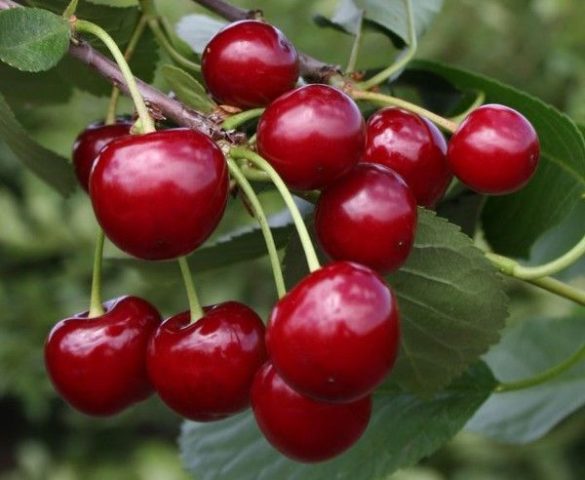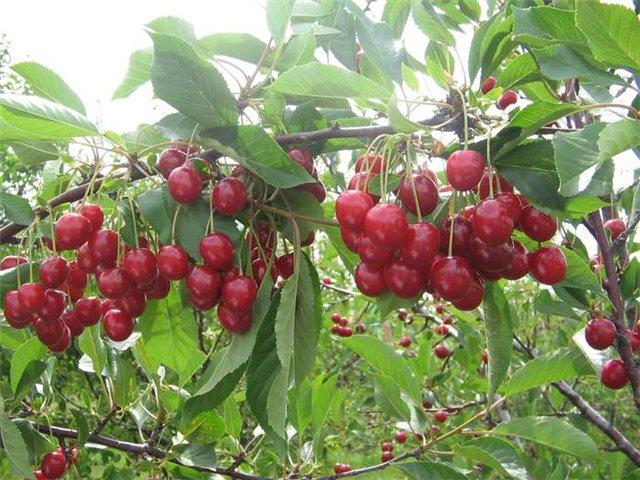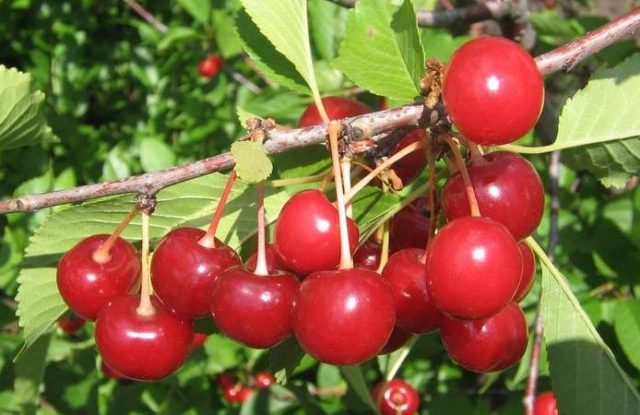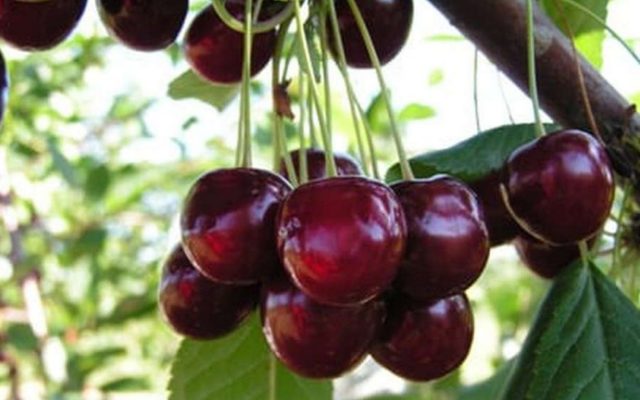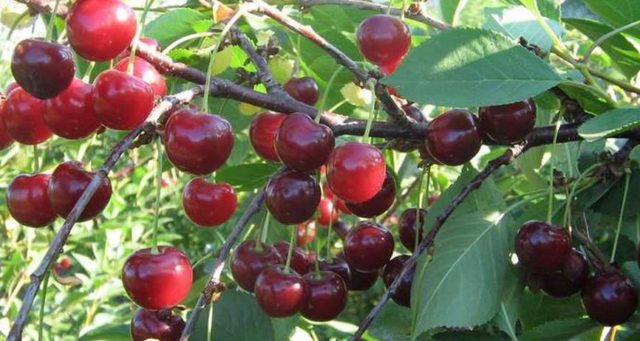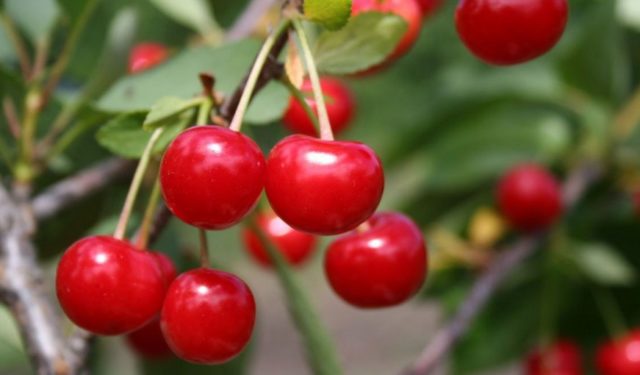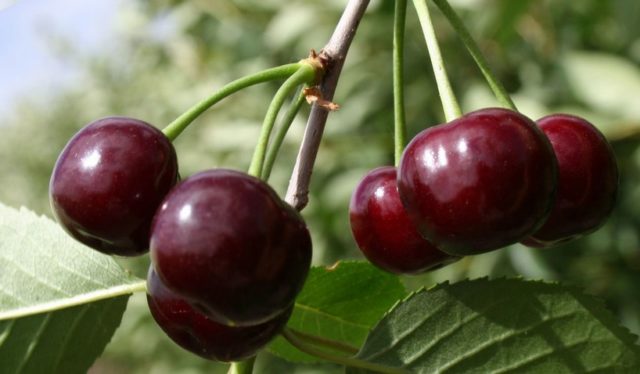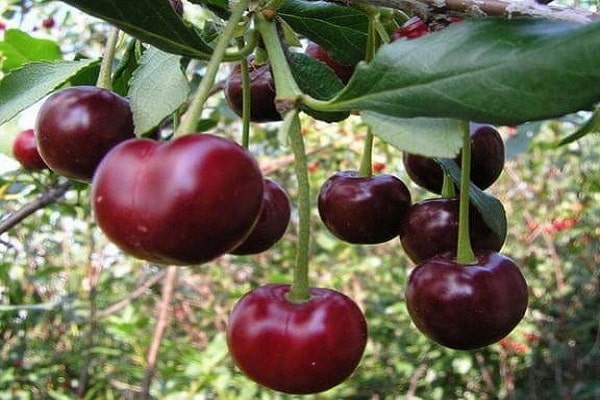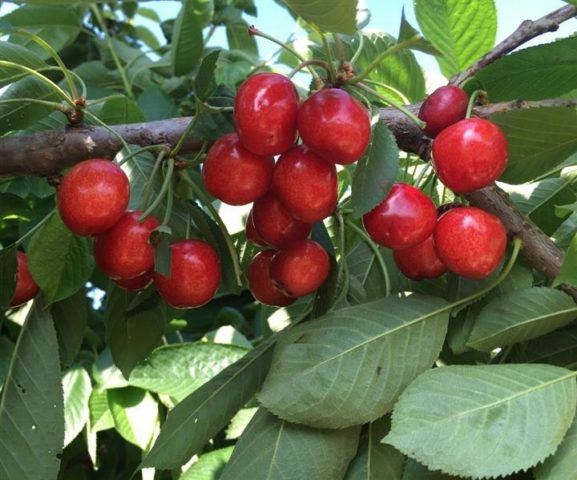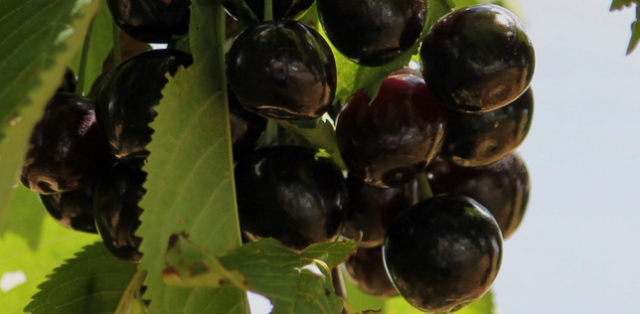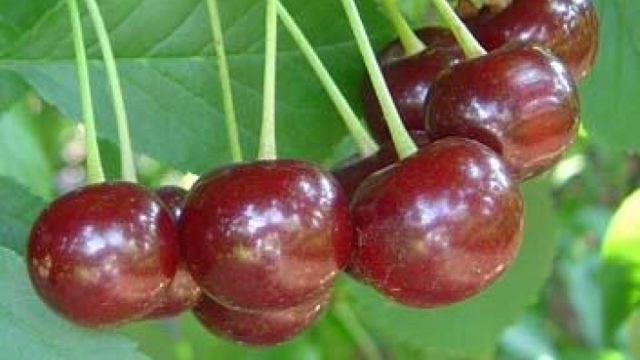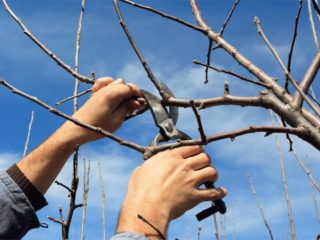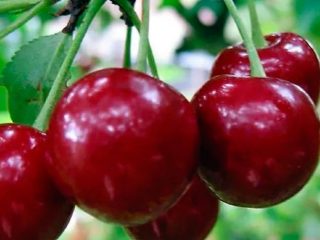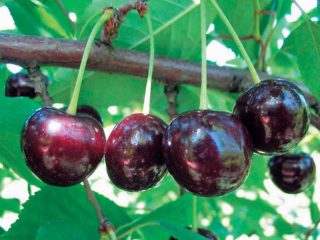Content
Cherry coccomycosis is a dangerous fungal disease of stone fruit trees. The danger is great if you ignore the first signs of the disease. If coccomycosis develops, it will affect almost all nearby trees. Over time, the plants will not be able to cope on their own due to the violation of their natural functions, and in the next winter they will die completely. However, by taking timely, simple measures to treat the trees, the garden can be saved.
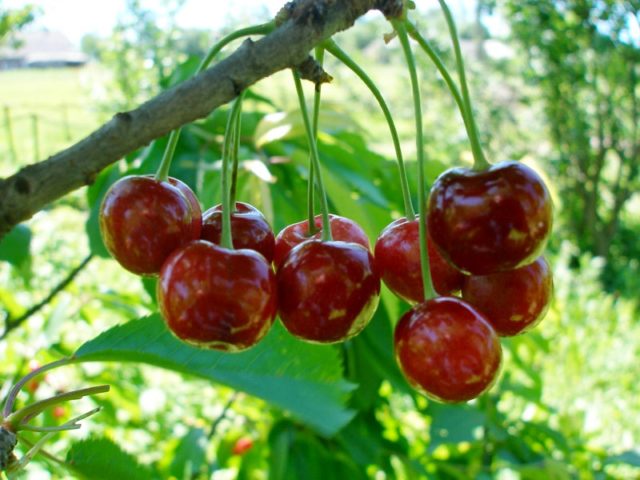
Cherry trees are more susceptible to coccomycosis than others.
Description of cherry disease "coccomycosis"
Coccomycosis is a fungal disease of cherries. Over the past century, it has spread throughout the territory of Russia, moreover, work on its study is only underway, that is, the disease has not been fully studied, from which it is considered dangerous.
Cherry disease is expressed as brown spots appearing on the foliage of the tree. Then, if nothing is done, do not process, the dots grow, affect all the foliage, and the fruits become covered with dark spots, become watery. Eating such berries is contraindicated. In a short time, the foliage turns yellow and disappears, but the troubles do not end there. On the fallen leaves, you can see the so-called spores - growths of a pale pink color. Cherry coccomycosis disease is shown in the photo:
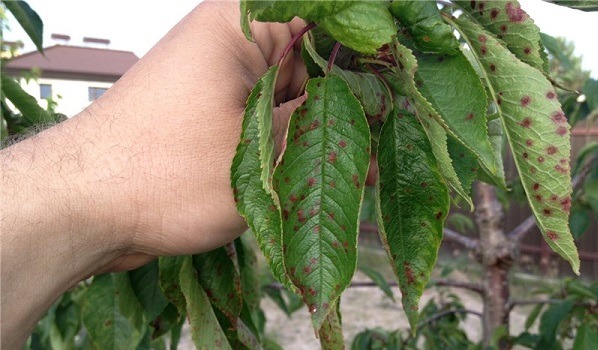
The first sign is red-brown spots
Signs of cherry coccomycosis infection
At the beginning of flowering, in spring, the first signal of the presence of a fungus is reddish-brown dots on the foliage, the so-called erosion. Subsequently, they increase in size, merging into one spot. On the reverse side of the leaf, there is a pale bloom, spores. In addition to foliage, berries are affected. They also stain, deform, deteriorate and dry out.
The disease develops so rapidly that it affects the entire tree by early summer. In addition to the loss of the cherry harvest, in the coming winter the tree may not survive the frost and die. It is also important to pay attention to the fact that spores are rapidly spread through the air and infect other crops. The lack of measures for the treatment of garden plants is dangerous because over time all fruit trees will get sick.
Why cherries get coccomycosis
Before proceeding to the treatment of cherry coccomycosis, it is worth understanding the reasons for its appearance. As you know, the fungus reached domestic gardens from Scandinavia. Only half a century ago, the first mentions of him appeared in the Lipetsk and Tambov regions. To date, coccomycosis is considered the youngest and most dangerous disease of stone fruit crops, especially cherries.
Spores of coccomycosis "winter" in fallen leaves, then are carried by the wind throughout the entire district.The peak of infection occurs in early spring, in damp weather, when the temperature is about 20 ° C. In a matter of weeks, the spores take root and infect trees that begin to bloom.
Why is coccomycosis dangerous for cherries?
Regardless of the age and fertility of the cherry tree, coccomycosis actively spreads throughout the plant, affecting leaf by leaf. When the berries (or fruits of other stone fruit trees) begin to ripen, they also lend themselves to deformation. In addition to external changes, irreversible internal changes begin. The tree loses its ability for standard wintering and is overcooled. Consequently, coccomycosis multiplies on the tree, killing it completely. To know what cherry coccomycosis looks like, you should study the photos and measures to combat garden ailment.
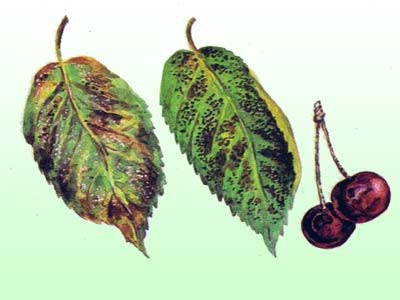
Fungal disease affects foliage and berries
How to treat cherry coccomycosis
It is worth fighting cherry coccomycosis when the first signs of the presence of a fungus appear. First you need to choose a suitable method of treatment, among which there are folk remedies prepared by yourself, purchased biological products or strong chemicals. In any case, you need to take care of the protection of the person who will deal with the treatment of horticultural crops.
Folk remedies for cherry coccomycosis
It is not enough to start treating cherries for coccomycosis in the spring with biological or chemical preparations. Folk remedies are designed to consolidate the positive result of treatment, to increase the resistance of cherries to the fungus. With the onset of warm days (when the temperature is close to 20 ° C), a solution is made from 2 kg of wood ash, 100 g of laundry soap and 10 liters of water. With this mixture, foliage is treated on both sides, all branches, bark, as well as the soil around the trunk. The procedure is carried out weekly before the onset of heat. Otherwise, under the influence of excess moisture, the plant will overheat and get burns. Harvesting is carried out according to the ripening of the cherry and depending on the variety, i.e. from the end of June to August. Before eating, the berries should not just be washed, it is recommended to pre-soak them in cool water for 20 minutes.
How to deal with coccomycosis on cherries with biological products
Cherry coccomycosis disease can be treated with biological products, but they are good at the initial stage of the development of the disease, as well as for prophylactic purposes. Their job is to apply a preparation containing special bacteria to the tree, which will begin active reproduction by feeding on fungal mycelium.
Moreover, these preparations help to improve the quality of berries, they are safe for the tree, good for insects. Depending on the drug chosen, it is applied at different stages. For example, "Mikosan", Bitoxibacillin "and" Fitodoctor "are applied after flowering. "Aktofit" - during the budding period. "Planriz" - shortly before the seasonal berry picking.
Despite the fact that biological products have a beneficial effect on the cherry tree, the berries must be thoroughly washed before use.
How to cure cherries from coccomycosis with chemicals
Cherry coccomycosis chemicals contain precise dosage instructions. Effective work is achieved when the diluted product is applied to dry foliage and left there for up to three hours.
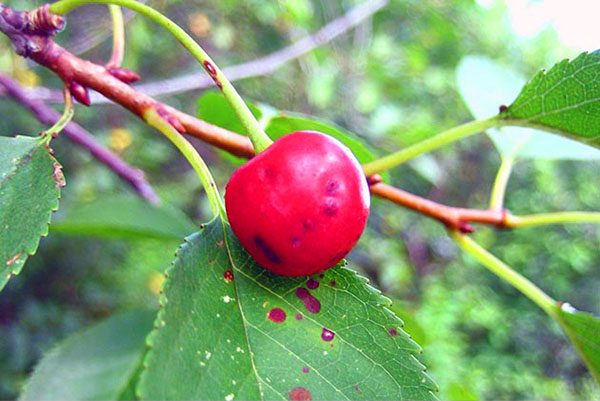
Chemical processing is carried out in several stages.
They begin to fight diseases in early spring, continue until the buds and flowers bloom. Reapplication of chemicals is carried out immediately after flowering. Then for the purpose of prevention after the seasonal harvest. Finally, in the fall, after the fall of leaves, a fixative chemical treatment is done.
It is noteworthy that they try not to apply chemicals directly to the fruits, but if the tree was so infected that it was necessary to process them, the berries are eaten after about 25 days, after thorough washing.
Mechanical control of cherry coccomycosis
At the first signs of coccomycosis, the infected branches are cut with pruning shears, and after each cut off the tool is treated with alcohol so as not to transfer spores on it to healthy parts of the culture. Cuts, cuts must be covered with garden pitch, less often with paint. Infected parts - branches and foliage - are collected and burned, or buried in holes up to 1 m deep. At the beginning of the spring season and in autumn, the soil is loosened to improve air circulation.
Rules for processing cherries from coccomycosis
It is believed that the most optimal treatment for cherries for coccomycosis will be in the spring. Considering that the active reproduction of the fungus is due to dampness and warming, the garden is cultivated in cloudy weather, without wind, in the early morning. It is important to spray absolutely the entire tree - foliage on both sides, trunk, branches, all bark and even soil. If the weather is rainy or with a high level of humidity, due to which warm evaporation occurs, the treatment is carried out more often to stop the fungus.
When can cherries be treated for coccomycosis
Depending on the chosen processing method, the cherries are sprayed several times. First, with the onset of the first warm days. Some remedies require regular reapplication on a weekly basis. Others - strictly before flowering, at the time of swelling of buds and flowers. Then the operation is repeated after flowering. The next processing step is carried out after picking the berries. Sometimes another treatment is required in the autumn after the foliage has fallen.
Personal protective measures
In the process of mechanical tree care, it is important for a gardener to use high-quality tools, thick gloves so as not to injure his hands, large transparent glasses so that branches and chips do not get into his eyes.
Chemical processing requires full equipment for the worker. A tight face mask, large transparent goggles, a rubber apron and long rubber gloves are required.
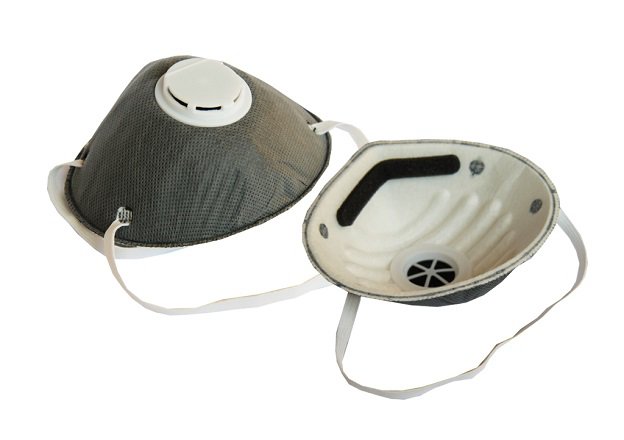
To avoid drug poisoning, you need to use protection
After the end of the procedure, be sure to take a shower and thoroughly wash your face and hands with laundry soap.
How to properly spray cherries for coccomycosis
Much depends on the chosen method of treatment for a fungal disease.
Processing with an ash-soap mixture is carried out every 1-1.5 weeks, starting with the onset of the first warm days (when the temperature is close to 20 ° C), in the early morning or in the evening, so that the sun does not scorch wet foliage. If the weather is wet, the treatment is carried out more often.
The use of biological products involves several stages of processing:
- In early spring, with the onset of the first warm days, when the trees wake up after wintering;
- At the beginning of budding;
- After the end of flowering;
- After collection;
- Before wintering, when the foliage is shed.
The whole tree, foliage, bark and branches are sprayed. It is noteworthy that biological products will not have to be applied to the fruits. The procedures are carried out early in the morning or in the evening, when the sun does not warm as hot as possible.
Chemical treatment is required when the tree is heavily infested and is carried out in five steps, as with biologics. It is important to apply the chemicals in dry weather so that the product remains indelible on the wood surface for at least three hours.
Spraying is carried out as much as possible - all the foliage on both sides, each branch, abundantly the entire trunk so that the bark is saturated with the drug. Be sure to spray the soil around the tree to exclude the development of spores in the ground.
Prevention measures
The fight against cherry coccomycosis is carried out in the spring, but for prevention purposes it is worth starting work in the fall. When the foliage falls off, it must be collected and burned.In the autumn and spring seasons, sanitary pruning of the crown of the tree is carried out, which should also be burned. Places of cuts are covered with the so-called garden varnish, which consists of paraffin, rosin and vegetable oil, or the finished product is purchased at a hardware store.
Young seedlings are painted with garden whitewash - a mixture of lime and vitriol. The whole seedling is covered with it for prophylaxis and if signs of commycosis are detected. In the presence of a disease, the seedlings are colored in the fall, after pruning. Thus, the "medicine" will penetrate into the bark, where fungus may also remain for the winter.
Cherry varieties resistant to coccomycosis
Early cherry varieties have proven to be resistant to fungal diseases. They begin to ripen even before favorable conditions for the spread of coccomycosis come.
These varieties include:
- In memory of Vavilov;
- Dessert Morozova;
- Early Yagunova;
- In memory of Yenikeev;
- Sudarushka.
Mid-ripening cherries are also resistant to coccomycosis:
- Rastorguevskaya;
- Frosting;
- Bulatnikovskaya;
- Silvia;
- Revival;
- Anthracite.
Late varieties that are resistant to fungal disease include:
- Nord Star;
- Tamaris;
- Robin.
Conclusion
Cherry coccomycosis is a fungal disease that affects stone fruit trees. It is successfully stopped in the early stages of its appearance. It is noteworthy that some cherry varieties are resistant to fungus. There are various methods of processing plants - folk, biological, chemical and mechanical. Observing the processing rules, coccomycosis is easily disposed of, and then the disease is prevented.

